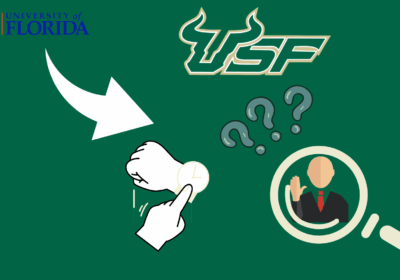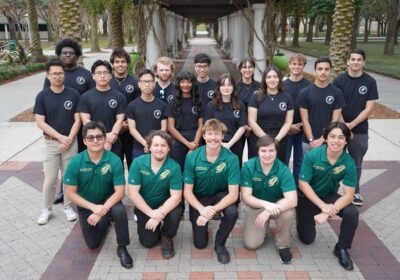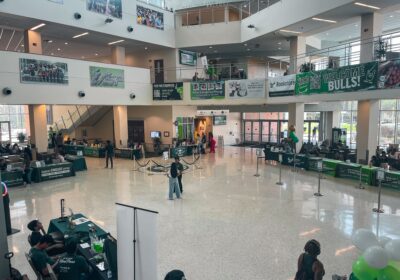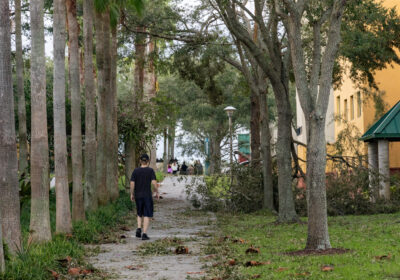Change, through their eyes

USF was established 60 years ago, in 1956. Classes first started in 1960. The campus early students remember, with vast expanses of sand and just four buildings to start, has since evolved into what today’s students know. SPECIAL TO THE ORACLE
Part 1 of 3: The 60s and 70s
A desert with sidewalks, complete with sandstorms and the rumor of wild boar.
That was how Ingrid Grunicke — a member of USF’s inaugural graduating class — viewed USF’s campus.
Hills and vast expanses of dirt accompanied by four or so buildings surrounded by woods were the backdrop to the class of 1963’s December graduation as they walked across a wooden stage built in the parking lot. Grunicke received a degree in sociology with a minor in psychology, one of 325 degrees awarded that day.
The modernized campus that freshman will cross for the first time this fall has come a long way from the campus of 60 years ago that Grunicke remembers. Cosmetic differences, which are vast, are accompanied by growth in programs, resources and presence that alumni spanning decades have recognized.
***
USF was founded in 1956, a little over a decade after the end of WWII. The U.S. was in the midst of the Cold War conflict with Russia.
When the first class started in 1960, the country was living in fear of communism. Search efforts and questioning of citizens to try to weed out communists and potential Russian spies ran amuck. The U.S. was also in the midst of the Civil Rights Movement.
“It was just a really, really weird time,” Grunicke said.
The times did not fail to touch the new university. Grunicke recalls during the Cuban Missile Crisis parents wanting to get their students out of Florida and sending them plane tickets, as well as the university holding drills for possible attacks.
“When we had drills, you had to pull the mattress off your bed — we had bunk beds — and you’d prop it up against the glass and then we’d all have to go out in the hall and shut the door,” she said. “Everybody brought their transistor radios and, of course, their cigarettes.
“We were just out there until the drill was over and then you could go back in and get your mattress flopped back on your bed.”
She also remembers rumors of right-wing extremist bodies on campus, such as the Johns Committee, bugging the bathrooms and taking students and professors to motels in the night to question them about possible radical left-wing affiliations.
“It was just a very paranoid atmosphere on campus when that stuff was going on because it really was like the Joe McCarthy stuff, just trying to get people to turn in other people and it was just really bad,” Grunicke said.
USF was also touched by the Civil Rights Movement. Grunicke remembers boycotting Scaglione’s University Restaurant, a non-USF affiliated popular off-campus restaurant where students often went to eat. The eatery, formerly located at the corner of Fowler and Bruce B. Downs, was one of two options to eat off-campus, the other one serving tiny hamburgers as its signature dish.
When the USF band went to the Scaglione’s, she recalled, the waitress did not serve an African American member of the band named Ernest Boger. Outraged, the students went to the then-Dean of Students to organize a boycott. The dean went over basic rules: don’t hit anyone back, stay off the property, etc.
“When it closed up, the drunks would come out and throw beer bottles and rocks and stuff like that,” she said. “Some cars got tipped over. Some people got followed back to the campus and got beat up. It was really pretty ugly.
“I think at the time it was really hard because I had some really good friends that didn’t want to participate in the boycott and it just really shocked me that … they didn’t feel as strongly about it as a lot of us did, which is kind of disappointing.”
Grunicke said she chose the university because of its close proximity to her hometown of Safety Harbor. She has many fond memories of her time there, like being a part of the class that got to pick the school’s colors and mascot.
When the students chose the Golden Brahman bull, Grunicke said, the university brought a real Brahman bull to sit atop a hill behind the old University Center.
She also remembers sticking paper in the in-door to keep it from closing all the way so that she could still get in, as she lived across from the RA’s room and at the time students had to sign in and out of residence halls.
“I really think about that stuff now and think ‘What did I go to school for?’” she said. “Well, to have a good time.”
***
In 1973, and again in 1975, MOSI Chief Operations Officer Vicki Ahrens graduated from USF and has since had a long history with USF. She graduated from USF with her bachelor’s in secondary science education in 1973 and her master’s in guidance counseling in 1975.
During her time at USF, she worked as a graduate assistant in USF’s Student Affairs department, where she was part of the development of the new student orientation program that took effect in 1972.
After graduating with her master’s degree, Ahrens went to work for USF’s Office of New Student Relations in freshman recruitment. She became the director of admissions in 1985 and then, in 1994, changed paths and moved to MOSI.
“As one who spent all of my adult life at USF, it created a little apprehension to leave the university and find out if there really was life after USF,” she said.
When Ahrens was looking at colleges in 1969 as a first generation college student, USF was a young university. While her friends from her Miami high school were looking at FSU and UF, Ahrens wanted to go somewhere different.
“(USF) was considered to be sort of a non-tradition institution because very few students lived on campus and it met my needs for me to strike out on my own,” she said.
It was a different time and a different campus. Ahrens remembers a lot of supervision of students. Visitation in residence halls between men and women was not allowed, and women had to check in and out of residence halls. Sorority houses didn’t sit in Greek village. Despite the separation, Ahrens said there were few barriers to women that she encountered in her own education.
“Other than the fact that there was a little more supervision than I think I wanted since I was now away at college and wanted to spread my wings and do my own thing, I think USF was a really positive environment for women,” she said.
Visually, Ahrens recalls a campus devoid of trees, without USF’s large entrance on Fowler Avenue and with many fewer buildings. Now, as a director in the USF Alumni Association Board of Directors, with a “finger on the pulse of the university,” Ahrens said watching USF continue to grow has been fun.
“What we’ve been able to see and watch is the university really mature into everything that a university is supposed to be,” she said. “… I spent 20 years/25 years on campus and when I go back today there’s almost nothing that feels familiar because the landscape of the campus has changed so dramatically.”
One of the most important differences to Ahrens was the inclusion of intercollegiate athletics, which weren’t around during her time as a student. She said she feels intercollegiate athletics provide a way for students to connect with the university in a way that other university organizations and activities don’t quite do.
“I think that for the university to continue to grow that it needs to have opportunities for students to develop connections with the university and, in our world, one of the best ways to do that is through intercollegiate athletics,” she said.
Her continued connection she said comes from a desire to give back and a love of affiliation. Some of her favorite memories from her time at USF are from her work with the new student orientation program and her social sorority.
The original orientation program that Ahrens was a part of had freshman staying for three days and two nights. Students were divided into small groups for advising, took tours and registered for classes using requests they filled out by hand that were then processed via computer. There was also an accompanying parent program.
“When I started school, we stood in lines at the gymnasium that went around the curvature of the Earth and pulled computer cards to try to get into class and it was the most difficult thing for people to do so changing all of that whole paradigm so that people could register for classes in a less stressful and more supportive way was significant,” she said.
Parts two and three of the “Change, through their eyes” series will be published on the Oracle website on Tuesday and Wednesday, respectively.







